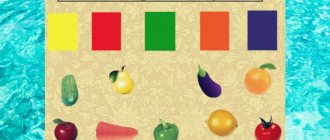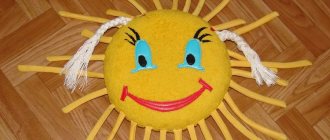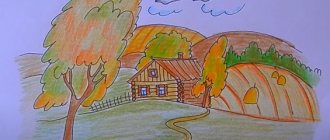GCD on “Artistic and Aesthetic Development” Topic: “Matryoshka Doll Painting”
GCD on “Artistic and Aesthetic Development”
Topic: “Matryoshka doll painting”
Target:
introducing children to the decorative painting of the folk toy - nesting dolls
Software tasks:
1.Educational
• consolidate children's knowledge about the history of the creation of the Russian wooden nesting doll, about its characteristic features;
• continue to get acquainted with the creativity of Russian folk art: painting of nesting dolls;
• consolidate practical skills in drawing elements of Semenovskaya painting;
2.Developing
• develop thinking, fine motor skills, artistic taste;
• develop children's creative abilities through exposure to folk art and applied arts;
• develop independence in coming up with a design for a sundress for a nesting doll.
3. Educational
• develop the ability to work in a team;
• cultivate independence, accuracy, interest and love for folk toys;
• cultivate respect for the creativity of Russian craftsmen.
Integrated educational areas:
“Cognition”, “Communication”, “Socialization”, “Music”, “Physical education”, “Health”.
Preliminary work: the teacher’s story about the history of the emergence of nesting dolls, their production and painting; examination of toys - nesting dolls and illustrations depicting nesting dolls of Semyonovsky, Zagorsky, Polkhov-Maidansky, comparing them in appearance, appearance, painting; reading poetry, riddles about nesting dolls.
Methodical techniques:
— Verbal
— Gaming
— Visual
Demo material:
presentation “Russian nesting doll”, easel, silhouettes of nesting dolls, illustrations with elements of different painting techniques, audio recordings “Russian folk melodies”
Handouts: nesting doll templates, paints, brushes, cotton swabs, woolen thread, jars of water, napkins.
Progress of the lesson:
1. Organizational moment.
(A folk melody sounds at the beginning of the lesson.)
There's a knock on the door. The teacher brings in a doll in Russian folk costume. She has an envelope in the rivers.
Educator: Guys, look what a beautiful doll, and she has an envelope in her hands, she probably brought us a letter. Let's read it.
The children sit on chairs, the teacher reads the letter: “Hello, dear children. Masters of Russian folk toys are writing to you. We have a lot of orders and we can't cope. We would like to ask you to help us make Russian folk toys."
2. Problem situation.
Educator: Guys, what Russian folk toys can you and I make?
Children's answers.
3. Statement of the topic and purpose of the lesson.
Educator: I have blank dolls, but they are not painted. I suggest you write them down. But first, let's remember what kind of nesting dolls there are and how they are painted.
4. Repetition of learned material
(slide 2)
There are dolls that have one name - Matryoshkas
(slide 3)
Why is this doll so loved? Because she's special. Disassembles into two parts. Take off the top one and see that there is still a doll inside. The same nesting doll, only smaller, and also opens up.
(slide 4)
The first nesting doll appeared almost a hundred years ago. Toy maker V. Zvezdochkin from the city of Sergiev Posad made a disassembled doll from wood, and artist S. Malyutin painted it. It turned out to be a girl, pink-cheeked, with flaxen hair, in simple peasant clothes - a sundress, an apron, and a scarf with flowers. With his right hand he presses a black rooster to himself.
(slide 5)
Why is the nesting doll called that?
In the old Russian village, the common and favorite female names were Matryona, Matryosha. This name means “mother”. That's why they called the doll Matryoshka.
(slide 6)
Matryoshka dolls are made mainly from linden, birch, alder, and aspen. Masters make matryoshka dolls starting with the smallest ones.
(slide7)
The craftswomen paint the finished figurines with bright colors - they “dress” the doll in colorful sundresses and colored scarves. And then the most difficult thing is to draw the face: eyes, crimson lips, blush - and the nesting doll “came to life.” They are also varnished for liveliness and shine.
(slide 
Matryoshka dolls were painted differently in different villages.
Sergievo Pasadsky - stable, thick-sided. In multi-colored aprons, in red, blue, green scarves.
(slide 9)
Matryoshka from Semenov - in colorful aprons, yellow and red shawls.
(slide 10)
And in the village of Polkhovsky Maidan, near the nesting dolls, raspberry berries, flowers, and green leaves are “scattered” on a yellow background. And they are slimmer.
(slide 11)
Sometimes the nesting dolls are unusual - they are a large peasant family.
(slide 12)
These are the heroes of fairy tales familiar to everyone.
(slide 13)
But still the most favorite was the nesting doll. Today it is known all over the world and is given as a souvenir of our country. It became a Russian souvenir.
5. Physical exercise.
(Musical round dance)
6. Practical part
Educator: I suggest you paint our nesting dolls in Semyonov style. Let's start painting with the scarf. What color?
Children's answers.
Educator: We place small flower buds along the edge of the scarf. We will draw them by dipping a cotton swab. The matryoshka’s apron is painted with roses; you and I can paint roses with woolen thread. Remember how we draw them?
Children's answers.
Educator: Now we take a brush and paint the bottom of the nesting doll. While we were painting the bottom, the roses dried up and complemented them with green leaves and scarlet flowers. The face is round, bright blush, black eyebrows, small mouth. The same image of a Russian beauty was sung in Russian songs and fairy tales.
7. Summing up.
(Organization of an exhibition of children's works)
— Well done, children, everyone did a wonderful job. When the paint dries, we will send the nesting dolls to the craftsmen.
Russian nesting dolls outline of a drawing lesson (preparatory group) on the topic
ON DECORATIVE DRAWING
Purpose: To introduce the history of the emergence of the matryoshka doll,
features of Russian matryoshka painting.
To develop children's cognitive interest, interest in the history and culture of Russia,
creativity and imagination, observation. Develop independence in coming up with a design for a sundress and an apron for a nesting doll.
To foster in children a sense of collectivism and a desire to jointly achieve the desired result. To cultivate aesthetic and artistic taste.
Related tasks: In the process of joint work, to form in children
the desire for active knowledge of reality.
Collective work is one of the ways of social cognition, provided that during their implementation attention is paid to the joint experience of embodied events.
Materials for the lesson: Wooden nesting dolls, silhouettes of nesting dolls for each child, gouache paints, visual aids.
Preliminary work: Examination of illustrations depicting Russian nesting dolls, didactic games “Collect a whole”, “Loto - nesting dolls.”
Educator: Guys, today we have an unusual lesson. Today we will become real toy painting artists. And we will paint these toys. (Drawing the children’s attention to the exhibition of nesting dolls). Guys, do you know these toys? What are their names? (answers).
This matryoshka doll is very loved by children and adults; it is special and can be disassembled into two parts. Everyone is happy about the toy. It's too good! It’s friendly, and there’s a whole family sitting inside. Sometimes 60 nesting dolls fit into one doll. The last one is the smallest - about the size of a pea. There are nesting dolls your size too. Listen to the nursery rhyme about the nesting doll:
Matryoshka dolls walked along the path
There were a few of them
Two Matryonas, three Matryoshkas
And also Matryoshka...
Let's find out how and who invented the nesting doll, where and how such toys are made.
- Matryoshka dolls are made in many cities of Russia.
Where did such a toy come from in Rus'?
— The first nesting doll was made 100 years ago in the ancient Russian city of Sergiev Posad. The prototype of the nesting doll could be “pysanka” - wooden, painted Easter eggs, they have been made in Rus' for many centuries. They are hollow inside, and the smaller is put into the larger. Another prototype of the Russian nesting doll was the Japanese ritual doll “daruma”, inside of which several more figures were placed.
— It’s not easy to make a matryoshka. First, you need to carve a blank from wood, so that there is no knot or crack. And the master begins his work with the smallest nesting dolls, only then their size becomes larger and larger. The artist paints the nesting dolls with bright, cheerful colors, as if he were dressing them in elegant clothes. And now the Russian beauty is smiling at us. What is she missing? She is not alone, but with a whole friendly family.
— At the end of the 19th century in Abramtsevo, based on a sketch by artist Sergei Malyutin, local turner Zvezdochkin turned the first wooden doll. And when Malyutin painted it, it turned out to be a girl in a Russian sundress, in a headscarf, with a rooster in her hand. According to legend, someone, seeing the doll, laughingly exclaimed: “How similar it is to our Matryona!” Since then this toy has been called a matryoshka.
Today, the nesting doll is already known all over the world. It has become a symbol of our country, a traditional Russian souvenir.
Guys, we have some delicate work ahead of us. Therefore, before we start, let's train our arms and legs too.
We are funny nesting dolls
We are funny nesting dolls -
We have boots on our feet,
In our colorful sundresses,
We look alike, like sisters
Okay, okay. (Arms are bent at the elbows, the index finger of the right hand rests on the right cheek. When pronouncing the words “okay, okay,” children clap their hands each time, show the “boots” on their feet, alternately place each foot on the toe, on the heel and click their heels. Then on the count of “one-two-three” they spin around, hands on the belt.)
The teacher invites the children to take seats at the tables to paint the nesting dolls.
Educator: Guys, you have silhouettes of nesting dolls on your table. I suggest you paint them with floral patterns. The matryoshka can be decorated with any painting, and it will become your original work.
First, you need to draw a face - draw the eyes, mouth, nose (The teacher shows how to do this correctly). Then we paint the scarf, shirt, sundress. Next, guys, use decorative elements (straight and wavy lines, dots, circles, flowers) for decoration.
Children work independently. The teacher provides verbal assistance. At the end of the work, an exhibition of drawings is held.
Simple drawing
To draw a simple drawing with your child, you need to follow several steps:
- Draw an egg with a blunt base.
- Draw a narrow stand on the base.
- At the top of the resulting oval, draw a circle for the face and bangs.
- Draw a face: eyes, nose, cheeks, smile and hair.
- Draw arms on both sides of the body.
To put on a matryoshka doll, you need:
- Draw 2 smooth lines under the circle of the face from the center to the sides. You will get a scarf.
- Draw the knot and ends of the scarf.
- At the bottom of the figure, draw the hem of the sundress.
- Draw any pattern on the apron: flower, berries, circles, and so on.
Zagorskaya matryoshka
This version of the pattern uses 4 primary colors - red or orange, yellow, green, blue:
- The drawing should begin by constructing a figure, which should be in the center of the sheet. It is necessary to mark on the paper the boundaries of the drawing at the top, bottom and sides. You will get a large frame.
- Draw a semicircle on top of the sheet. This will be the face of the toy.
- The body looks like an oval.
- Outline the head and body with a single line. Remove extra lines with an eraser. You will get the silhouette of a matryoshka doll.
- Outline a round face.
- Then draw a bow on the scarf and its bottom edge.
- Under the scarf on the neck, draw the upper part of the sundress.
- If it is difficult for children to draw hands, you can make a figure without them. Therefore, all that remains is to draw an apron with openwork embroidery along the edge.
- Outline the hairstyle. Usually this is a symmetrical bang.
- Outline the eyes, nose and mouth.
The initial stage of building the nesting doll is completed.
To make a toy in color, you need to follow these steps:
- Cover the scarf with blue.
- Blue color can be used to decorate an apron. For example, draw a strip along its edge and on the belt.
- To fill the sundress, you can use red.
- The apron can be painted yellow.
- Yellow can be used to color the face and neck.
- Paint your hair orange.
After the main color masses are filled in, you can move on to painting, consisting of dots, leaves and flowers.
It is more convenient for a child to make dots with cotton swabs.
- Place red paint on one cotton swab and yellow paint on the other and create flowers on a scarf of the same size using dots.
- Make the same flowers on the apron using red and orange.
- Place yellow dots on the apron stripe and blue dots on the openwork edge.
- You can choose red for the dots on the apron waistband.
- Beads can be made from dots of different colors.
- To make the petals, you need to take a thin brush and paint it with green color. Then, applying the entire thickness of the brush to a sheet of paper, form openwork foliage.
- You can create a leaf pattern by pressing the leaf with the entire surface of the brush or just the tip.
- Make eyes and cheeks using cotton swabs.
- Use a thin brush to make a bow on the lips, and outline the eyebrows, eyelashes and nose using a felt-tip pen.
- Trace all the details of the nesting doll with a felt-tip pen.
You can draw a matryoshka without an apron. In her hands you can place apples, a samovar, a pretzel, a mug, a teapot.
GCD for drawing in the preparatory group “Merry dolls”
Marina Shekel
GCD for drawing in the preparatory group “Merry dolls”
Program content: continue to introduce children to the nesting doll as a type of folk toy (history of creation, features of appearance and decor, source material, the most famous crafts - Semyonovskaya, Polkhov-Maidanskaya, develop the ability to draw a nesting doll from life , as accurately as possible conveying the shape, proportions and design elements, develop an eye, a sense of color, shape, rhythm, proportion, cultivate interest in folk culture, aesthetic taste.
On the topic: methodological developments, presentations and notes
Summary of a lesson on familiarizing children with their surroundings. Topic: “Toys. Getting to know the Russian nesting doll" - from a series of integrated lessons on the topic: "Matryoshka".
The activity will help introduce children to the folk toy - matryoshka. Integration of educational areas: "Cognition", "Artistic creativity", "Communication", "Music".
Long term project. For preschool teachers.
Application for the middle group of kindergarten, from the “Our Motherland” section.
Program content: Educational objectives: Tell about the most popular folk wooden toy, nesting dolls. Teach children to distinguish between different techniques for painting nesting dolls. Develop children's creative imagination.
Introduction to Russian folk culture should be introduced from early childhood.
Source







